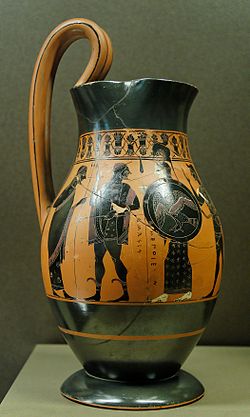Amasis Painter
| Amasis Painter | |
|---|---|

Heracles entering Mount Olympus, olpe by the Amasis Painter, dated to within 550–530 BC. Inscription: AMASIS MEΠOIESEN, Amasis m'epoiesen, "Amasis made (me)". Located in the Louvre Museum, Paris.
|
|
| Born |
Amasis Before 550 BC Athens or Egypt |
| Died | About 510 BC |
| Nationality | Greek or Egyptian, the latter preferred |
| Known for | Vase painting |
| Notable work | About 90 vase paintings |
| Movement | Black-figure style |
| Patron(s) | Possibly Solon, if he was from Egypt |
The Amasis Painter (active around 550–510 BC in Athens) was an ancient Greek vase painter who worked in the black-figure technique. He owes his name to the signature of the potter Amasis ("Amasis made me"), who signed 12 works painted by the same hand. At the time of the exhibition, "The Amasis Painter and His World" (1985), 132 vases had been attributed to this artist.
As with any of the artisans working during the sixth century BC, very little is understood about the Amasis Painter's life or personality. Scholars do know that Amasis is a Greek version of an Egyptian name, more specifically of a contemporary Egyptian king, leading some to believe that the Amasis Painter—or at least the potter Amasis—may have been a foreigner, originally from Egypt. Other possibilities include that he was an Athenian with an Egyptian name, which is highly plausible, given close trade relations between Greece and Egypt, or that his signed name was a nickname given to him by his contemporaries due to some Egyptian characteristic, an example being the alabastron shape.Exekias’s use of the label “Amasos” for an illustration of an Ethiopian has no clear explanation, but he is generally thought to have been poking fun at Amasis as a contemporary professional rival.
Despite the possibility of his Egyptian origin, it is generally agreed by scholars that the Amasis Painter learned his trade in Athens, most likely with the Heidelberg Painter. This painter worked around 525–550 BC, and is best known for his work on Siana cups. The Amasis Painter borrows scenes from the Heidelberg Painter, such as a warrior dressing himself in greaves with multiple bystanders; however, the Amasis Painter adds his own touch in the treatment of his figures, imparting a greater sense of detail, and often adding a signature double-band border and palmette-lotus festoon to the ornamental decoration. In other examples, the Amasis Painter’s use of fringed garments also emphasizes a possible close relationship between the two.
The career of the Amasis Painter was long, spanning nearly 50 years from around 560 to 515 BC, and encompassed the transition from the early to mature phases in Attic black-figure vase painting. The Amasis Painter was singular in his reaction to the rapid changes happening around him. His style, while generally conservative, evolved with certain developments in the medium. However, the Amasis Painter also rejected certain trends and managed to maintain a consistency that can be traced throughout, making it difficult to date works within his lifetime. His development over the course of his career, which is loosely classified into early, middle and late phases, demonstrates the artist’s journey from novice to master. As R. M. Cook explains, "His early work is conventional and tame, but as he matures he displays a more individual assurance".
...
Wikipedia
